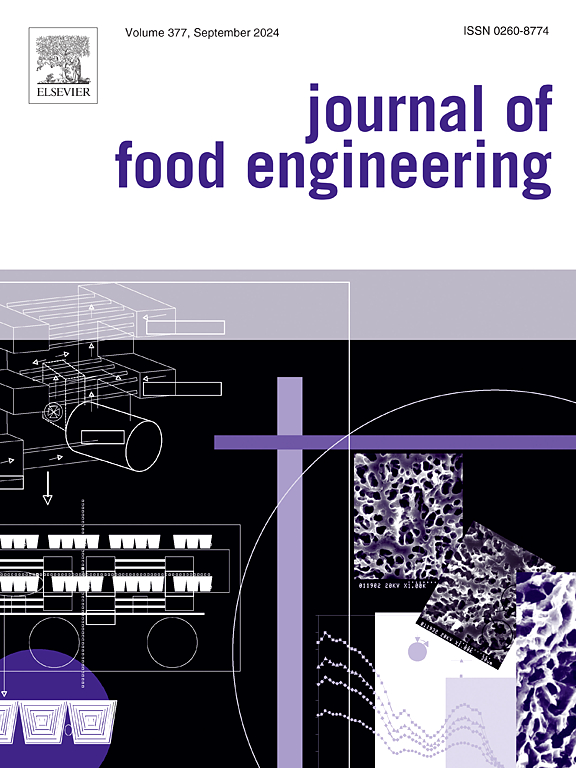Encapsulation of curcumin in casein-dextran sulfate nanocomplexes for enhanced acid stability and bioaccessibility
IF 5.3
2区 农林科学
Q1 ENGINEERING, CHEMICAL
引用次数: 0
Abstract
Casein is commonly used to encapsulate lipophilic polyphenols such as curcumin. However, casein capsules precipitate at ∼ pH 3–5.5. Sodium caseinate (NaCas)-dextran sulfate (DS) nanocomplexes were studied in this work to encapsulate curcumin for acid stability and bioaccessibility. Compounds were dissolved at pH 13.0, followed by adjusting pH to 7.0, 4.6, and 3.0. The chosen formulation (3.0 mg/mL curcumin, 5.0 mg/mL NaCas, and 5.0 mg/mL DS) led to an encapsulation efficiency (EE) of 94.8%, 90.2%, and 77.3% and loading capacity of 38.1%, 35.3%, and 34.5% at pH 7.0, 4.6, and 3.0, respectively. The EE of curcumin-loaded NaCas/DS nanocomplex dispersions remained similar (P > 0.05) at pH 7.0 and 4.6 during 31-day ambient storage while at pH 3.0, slight precipitation decreased the EE by about 9% after 31 days. The Z-average diameter of dispersions was bigger at a lower pH and was smaller than 225 nm. During ambient storage, the Z-average diameter of dispersions was mostly stable. Encapsulation had no impact on the antioxidant capacity of curcumin but increased the bioaccessibility of curcumin to more than 53%, resulting from the amorphous curcumin structure. Therefore, NaCas/DS nanocomplexes have the potential of delivering curcumin in functional beverages, especially in acidic conditions.
姜黄素在酪蛋白-葡聚糖硫酸盐纳米复合物中的包封,以增强酸稳定性和生物可及性
酪蛋白通常用于封装亲脂性多酚,如姜黄素。然而,酪蛋白胶囊在~ pH 3-5.5下沉淀。研究了酪蛋白酸钠(NaCas)-硫酸葡聚糖(DS)纳米配合物包封姜黄素的酸稳定性和生物可及性。化合物溶解在pH 13.0,然后调整pH为7.0,4.6和3.0。在pH 7.0、4.6、3.0条件下,姜黄素3.0 mg/mL、NaCas 5.0 mg/mL、DS 5.0 mg/mL的包封率分别为94.8%、90.2%、77.3%,载药量分别为38.1%、35.3%、34.5%。负载姜黄素的NaCas/DS纳米复合物分散体的EE保持相似(P >;0.05),在pH 7.0和4.6条件下贮藏31 d,而在pH 3.0条件下,轻微的降水使31 d后的EE降低了约9%。在较低的pH下,分散体的z平均直径较大,小于225 nm。在环境贮存期间,分散体的z平均直径基本稳定。包封对姜黄素的抗氧化能力没有影响,但由于姜黄素的无定形结构,使姜黄素的生物可及性提高了53%以上。因此,NaCas/DS纳米复合物具有在功能性饮料中输送姜黄素的潜力,特别是在酸性条件下。
本文章由计算机程序翻译,如有差异,请以英文原文为准。
求助全文
约1分钟内获得全文
求助全文
来源期刊

Journal of Food Engineering
工程技术-工程:化工
CiteScore
11.80
自引率
5.50%
发文量
275
审稿时长
24 days
期刊介绍:
The journal publishes original research and review papers on any subject at the interface between food and engineering, particularly those of relevance to industry, including:
Engineering properties of foods, food physics and physical chemistry; processing, measurement, control, packaging, storage and distribution; engineering aspects of the design and production of novel foods and of food service and catering; design and operation of food processes, plant and equipment; economics of food engineering, including the economics of alternative processes.
Accounts of food engineering achievements are of particular value.
 求助内容:
求助内容: 应助结果提醒方式:
应助结果提醒方式:


